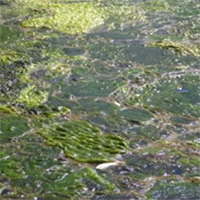Sediment phosphorus release sustains nuisance periphyton growth when nitrogen is not limiting
Sediment phosphorus sustains nuisance periphyton

All claims expressed in this article are solely those of the authors and do not necessarily represent those of their affiliated organizations, or those of the publisher, the editors and the reviewers. Any product that may be evaluated in this article or claim that may be made by its manufacturer is not guaranteed or endorsed by the publisher.
Authors
Nuisance periphyton growth influences the aesthetics, recreation, and aquatic life of waterbodies. Partners Lake is a shallow spring-fed lake in the headwaters of the Illinois River Watershed in Cave Springs, Arkansas, that experiences nuisance growth of periphyton (i.e., Spirogyra spp.) each year. The ratio of dissolved nitrogen (N ~5.0 mg L-1) and phosphorus (P ~0.030 mg L-1) in the lake water (N:P≥288), as well as nutrient limitation assays, suggests that periphyton growth should be P-limited. While the water column lacks sufficient P to promote growth, the sediments have the ability to release P to the overlying water; P-flux ranged from 1.63 mg m-2 d-1 to over 10 mg m-2 d-1, reaching final concentrations of 0.08 to 0.34 mg L-1. However, soluble reactive phosphorus concentrations were consistently at or below 0.030 mg L-1, in the lake, suggesting that the periphyton were likely immobilizing P as quickly as it was released from the sediments. In the lab, maximal periphyton growth (~30 to 35 mg m-2) occurred in the 0.10 to 0.25 mg L-1 P treatments, over a 6 day incubation period. Similar levels of growth occurred when lake sediments were the P source, suggesting P released from the sediments is sufficient to support nuisance algal growth. We need to begin managing the legacy P stored in the sediments, in addition to external P loads, because internal P can sustain nuisance periphyton biomass when N is not limiting.






